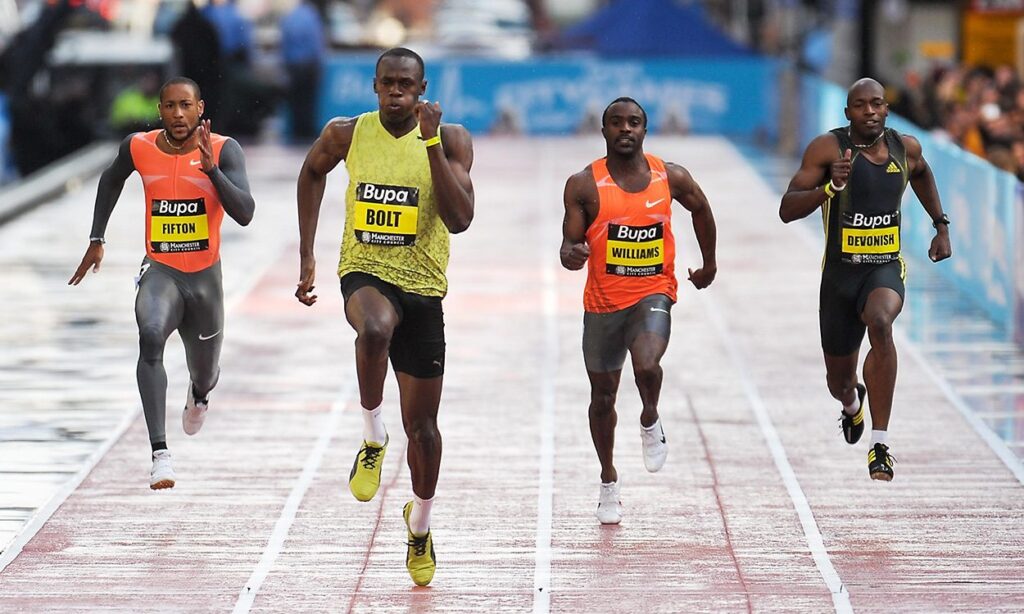Usain Bolt Top Speed is nothing short of legendary. As the fastest man in history, Bolt reached an incredible speed of 27.79 miles per hour during his 100-meter world record run. This jaw-dropping moment occurred at the 2009 World Championships in Berlin, and it still stands as the fastest 100-meter sprint ever recorded. His top speed is a testament to his extraordinary athletic abilities and years of dedicated training.
When you think of Usain Bolt’s top speed, you picture a blur crossing the finish line in record time. No one has been able to match this record since then, making him the undisputed champion of sprinting. But what makes Usain Bolt’s speed so special? Let’s dive into the details of how he reached such incredible speeds and why he’s still the fastest man on Earth.
Contents
Usain Bolt Top Speed: The Science Behind His Lightning Fast Runs
Usain Bolt’s top speed is one of the most remarkable feats in athletics. The secret behind this incredible speed lies in the science of sprinting. When Bolt sprints, his muscles move in perfect coordination. He uses his long stride to cover more ground with each step, which helps him run faster than most athletes.
His body structure plays a huge role in his success. Bolt’s legs are long and strong, giving him an advantage over other sprinters. His calves and thighs are built for explosive power, which helps him maintain his speed during the race. Additionally, his running technique is optimized for maximum efficiency.
Another key factor is the speed of his reaction time. Bolt’s start isn’t the quickest, but his top speed during the middle and final parts of the race is unmatched. His muscles fire at the right moment, helping him reach his peak speed.
Through a combination of genetics, training, and technique, Bolt was able to push the limits of human speed. It’s not just about running fast; it’s about making every part of your body work together to achieve perfection.
How Usain Bolt Top Speed Changed the History of Sprinting
Usain Bolt’s top speed didn’t just set records—it changed the entire world of sprinting. Before Bolt, sprinters were already fast, but no one could achieve the same level of speed and power that he brought to the track. His 9.58-second 100-meter race in 2009 stunned the world.
Bolt’s performance inspired sprinters worldwide to rethink their training methods. Coaches started focusing more on developing the explosive power needed to run faster. His record has pushed many athletes to improve their technique and physical strength.
Before Bolt, the 100 meters had a standard pace, but Bolt shattered that. His consistency at the top of the game showed that speed in track and field could go beyond anyone’s expectations. His success became a benchmark for what’s possible in sprinting.
Today, many athletes dream of breaking Bolt’s records. They look to him for inspiration, trying to match his top speed and dominate their events. His impact on the sport is still felt, and his name remains synonymous with speed.
Usain Bolt Top Speed vs. The Average Human: What Makes Him So Fast
The difference between Usain Bolt’s top speed and the average human’s speed is massive. While most people can sprint at speeds of around 12-15 miles per hour, Bolt reached a top speed of 27.79 miles per hour during his 100-meter world record. This huge difference is due to several factors that make Bolt so exceptional.
Genetics and Body Type
- Long limbs: Bolt’s long legs allow him to take fewer strides while covering more distance.
- Strong muscles: His powerful muscles help him sprint at top speed and maintain it.
- High stamina: He can keep up his speed throughout the race, even in the final meters.
Training and Technique
- Sprint drills: Bolt’s intense training helps improve his sprinting form.
- Explosive power: His ability to generate fast starts and keep up speed is a result of his strength and explosive power.
- Efficiency: Bolt’s technique helps him use less energy, allowing him to go faster for longer.
Bolt’s top speed is not just about running faster; it’s about optimizing every part of his body and training it to perfection.
Conclusion
In conclusion, Usain Bolt’s top speed is truly one of a kind. His incredible 27.79 miles per hour during the 2009 World Championships in Berlin is a record that still stands today. Bolt’s unique combination of genetics, training, and technique made him the fastest man in history. He has set a standard that athletes around the world continue to chase.
Even though his record has stood the test of time, the future of sprinting remains exciting. With new technologies and training methods, we might see athletes come close to or even beat Bolt’s top speed someday. But for now, Usain Bolt’s legacy as the fastest person ever will continue to inspire generations of sprinters.
FAQs
Q: What is Usain Bolt’s top speed?
A: Usain Bolt’s top speed is 27.79 miles per hour, which he reached during his world record 100-meter run at the 2009 World Championships in Berlin.
Q: Why is Usain Bolt so fast?
A: Usain Bolt’s speed comes from his long legs, powerful muscles, and perfect running technique. His training also helped him maintain his top speed during races.
Q: Can anyone break Usain Bolt’s speed record?
A: It’s hard to say, but with better technology and training, future athletes may get close to Bolt’s record. His speed is a tough one to beat!
Q: What was Usain Bolt’s 100-meter world record time?
A: Usain Bolt’s 100-meter world record is 9.58 seconds, which he set in 2009 at the World Championships in Berlin.
Q: When did Usain Bolt retire from sprinting?
A: Usain Bolt retired from competitive sprinting in 2017 after the World Championships in London, where he suffered a hamstring injury during a relay race.
